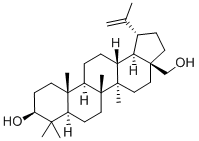473-98-3

Product Name:
Betulin
Formula:
C30H50O2
Synonyms:
Trochol;Betulinol;Betulol;Lup-20(29)-ene-3β,28-diol;Lup-20(29)-ene-3β,28-diol, Sterol Regulatory Element Binding Protein Processing Inhibitor, Betulin
Inquiry
CHEMICAL AND PHYSICAL PROPERTIES
| Physical Description | Solid |
|---|---|
| Boiling Point | 284.00 to 288.00 °C. @ 743.00 mm Hg |
| Melting Point | 251 - 252 °C |
| Collision Cross Section | 208.3 Ų [M+Na]+ [CCS Type: TW, Method: calibrated with polyalanine and drug standards] |
SAFETY INFORMATION
| Signal word | Warning |
|---|---|
| Pictogram(s) |
 Health Hazard GHS08 |
| GHS Hazard Statements |
H371:Specific target organ toxicity, single exposure |
| Precautionary Statement Codes |
P260:Do not breathe dust/fume/gas/mist/vapours/spray. P264:Wash hands thoroughly after handling. P264:Wash skin thouroughly after handling. P270:Do not eat, drink or smoke when using this product. P405:Store locked up. P501:Dispose of contents/container to..… |
COMPUTED DESCRIPTORS
| Molecular Weight | 442.7 g/mol |
|---|---|
| XLogP3 | 8.3 |
| Hydrogen Bond Donor Count | 2 |
| Hydrogen Bond Acceptor Count | 2 |
| Rotatable Bond Count | 2 |
| Exact Mass | 442.381080833 g/mol |
| Monoisotopic Mass | 442.381080833 g/mol |
| Topological Polar Surface Area | 40.5 Ų |
| Heavy Atom Count | 32 |
| Formal Charge | 0 |
| Complexity | 786 |
| Isotope Atom Count | 0 |
| Defined Atom Stereocenter Count | 10 |
| Undefined Atom Stereocenter Count | 0 |
| Defined Bond Stereocenter Count | 0 |
| Undefined Bond Stereocenter Count | 0 |
| Covalently-Bonded Unit Count | 1 |
| Compound Is Canonicalized | Yes |
PRODUCT INTRODUCTION
description
Betulin is a pentacyclic triterpenoid that is lupane having a double bond at position 20(29) as well as 3beta-hydroxy and 28-hydroxymethyl substituents. It has a role as a metabolite, an antiviral agent, an analgesic, an anti-inflammatory agent and an antineoplastic agent. It is a pentacyclic triterpenoid and a diol. It derives from a hydride of a lupane.